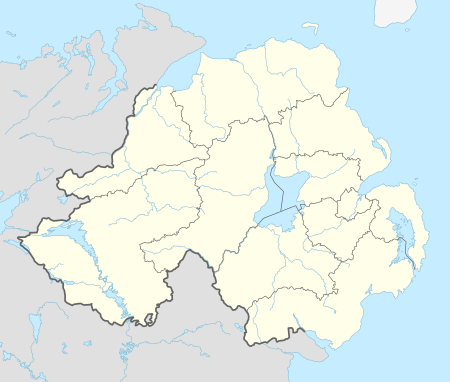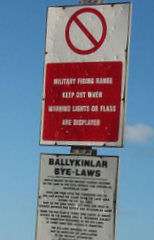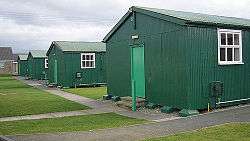Abercorn Barracks
| Abercorn Barracks | |
|---|---|
| Ballykinler | |
|
Abercorn Barracks | |
 Abercorn Barracks Location within Northern Ireland | |
| Coordinates | 54°15′26″N 05°48′01″W / 54.25722°N 5.80028°WCoordinates: 54°15′26″N 05°48′01″W / 54.25722°N 5.80028°W |
| Type | Barracks |
| Site information | |
| Owner | Ministry of Defence |
| Operator |
|
| Site history | |
| Built | 1901 |
| Built for | War Office |
| In use | 1901-Present |
Abercorn Barracks, sometimes referred to as Ballykinlar Barracks or Ballykinler Barracks, is a military installation in Ballykinler in County Down, Northern Ireland.
Early history
The barracks, which were named after James Hamilton, 1st Duke of Abercorn who was twice Lord Lieutenant of Ireland, were built in 1901.[1]
Internment at Ballykinlar

The sprawling site of Ballykinlar Barracks was pressed into service as an internment camp during the Irish War of Independence in 1919.[2] After the Partition of Ireland, the new Government of Northern Ireland continued to use the base for internment.[3] There appear to have been attempts by those incarcerated to maintain a normal social structure within the confines of the camp and evidence exists of an orchestra and some examples of typical prisoner art are still available for viewing in museum collections in Ireland, including examples of humorous cartoons.[2] 'Camp tokens' also circulated within the camp in place of money, being made of printed cardboard.[4]
A former IRA prisoner, Louis J. Walsh (a native of County Londonderry and later a judge in County Donegal), published a book in 1921 about his experiences in various institutions in Northern Ireland including a chapter about his time in Ballykinlar Camp which describes, amongst other things, having to march for three miles, handcuffed and carrying luggage, only to be placed in bare huts with nothing to sleep in except damp straw. He continues in a second chapter to describe how the prisoners set up their own 'Council' which then began to negotiate with the military authorities for better food and conditions within the camp. "The camp regime was notoriously brutal - prisoners were shot dead for minor infractions, such as standing too close to the barbed wire fence that kept them penned in (the camp magazine was titled Barbed Wire)." Ballykinlar internment camp housed over 2,000 men from the thirty-two counties of Ireland and was the first mass internment camp in Ireland during the Irish War of Independence.[5] Three prisoners were shot dead and five died of malnourishment in Ballykinlar in 1921 alone.[4]
After peace was declared in 1921 the internees were released but it does appear that their ordeal did not necessarily end after leaving as evidence exists that a train carrying released prisoners from Ballykinlar was attacked at Thurles, County Tipperary, injuring three Sinn Féin passengers and several members of the crowd.[6]
Military uses
In World War I the 36th Ulster Division formed from the Ulster Volunteers did much of its training at Ballykinlar.[7] A journalist of the time writing in the Belfast Newsletter waxed lyrical about the location describing it as a "camp situated in the centre of picturesque country, with the mountains of Mourne forming an imposing background. On the edge of the camping ground, and within easy walking distance of the tents, is an arm of Dundrum Bay, and here the men will have swimming and bathing drills. Within sight of the camp is the beautifully situated demesne of Tyrella."[8]
In World War II the camp continued to be a military training establishment and the North Irish Horse record moving there to take over Valentine Tanks and convert to an armoured regiment.[9] Troops from the United States, including those from the 1st Armored Division[10] also trained at Ballykinlar.[11]
The year 1974 saw the Troubles in Ballykinler when a 300 lb Provisional Irish Republican Army van bomb killed two British Army soldiers, injured many others and destroyed some buildings on the base.[12] Private Swanick was a member of the Duke of Edinburgh's Royal Regiment and Corporal Coughlan a member of the Royal Welch Fusiliers.[13]
The base was used as a training centre in the 1970s and 1980s by the Ulster Defence Regiment whose 3rd (County Down) Battalion was also based there. [14]
As peace has returned to Northern Ireland the British troops based there were withdrawn from the streets with the ending of Operation Banner and are now Garrison troops. In 2008 it was announced that the 2nd Battalion of The Rifles based at Ballykinlar would be deployed to Kosovo to "combat fresh violence between ethnic Albanians and minority Serbs." [15]
Sandes Home, the civilian charity which provides leisure and restaurant facilities in some bases, has had a presence at Ballykinlar Camp for over 100 years. In early 2009 a car bomb was found close to the base, which was thought to have been abandoned by dissident republicans.[16]
Recent military use
Major renovation was carried out at the Barracks in 2008 and the camp now has 290 married quarters.[17] The 2nd Battalion The Rifles are due to move out to Thiepval Barracks in June 2014.[18] In November 2016 the Ministry of Defence announced that the site would close in 2018.[19]
References
- ↑ "Fears That Ballykinler Army Camp Is On A Slippery Slope". Down News. 8 January 2014. Retrieved 27 April 2014.
- 1 2 "Ballykinlar Collection". Your Place and Mine - BBC. Retrieved 2008-06-17.
- ↑ "Internment in Northern Ireland 1922-1961". Internment (by John McGuffin, 1973). Archived from the original on 9 May 2008. Retrieved 2008-06-17.
- 1 2 "O'Brien Coin Guide: Ballykinlar Internment Camp Tokens (1920-21)". 13 November 2015. Retrieved 18 June 2016.
- ↑ Liam O'Duibhir, Prisoners of War - Ballykinlar Internment Camp 1920-1921, (2013), Mercier Press. ISBN 978 1 78117 0410
- ↑ "Freed Prisoners Train is Bombed". New York Times (10 December 1921). 1921-12-10. Retrieved 2008-06-17.
- ↑ Down County Museum Archived September 26, 2011, at the Wayback Machine.
- ↑ "Volunteers at the World's End: the Ulster Division at Ballykindler Army Camp". Retrieved 12 October 2014.
- ↑ "War Diaries for the North Irish Horse". North Irish Horse website. Retrieved 2008-06-17.
- ↑ "The Americans". Second World War NI. Retrieved 2008-06-17.
- ↑ "GIs Return to Down". Your Place and Mine - BBC. Retrieved 2008-06-17.
- ↑ "The bombing of Sandes Soldiers Home, Ballykinler". 1st Bn Duke of Edinburgh's Royal Regiment. Retrieved 25 January 2010.
- ↑ "Duke of Edinburgh's Royal Regiment". Palace Barracks Memorial Garden. Retrieved 25 January 2010.
- ↑ Ryder 191
- ↑ "Troops in Ulster to combat Kosovo violence". Yorkshire Post (30 April 2008). Retrieved 2008-06-17.
- ↑ "Abandoned Car Bomb". BBC News (31 January 2009). 2009-01-31. Archived from the original on 1 February 2009. Retrieved 2009-01-31.
- ↑ "Ballykinler barracks 'could close in 2016'". Newsletter. 23 July 2009. Retrieved 27 April 2014.
- ↑ "Army's retreat from Ballykinler base raises fears for civilian posts". Belfast Telegraph. 23 December 2013. Retrieved 27 April 2014.
- ↑ "A Better Defence Estate" (PDF). Ministry of Defence. November 2016. Retrieved 8 November 2016.
